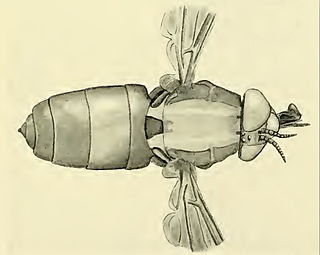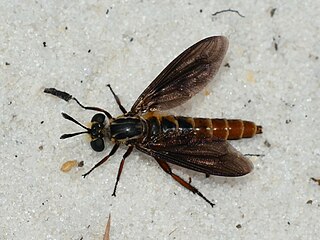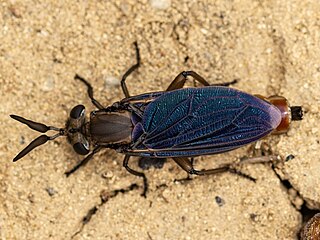
The Mydidae, or Mydas flies, are a cosmopolitan family of flies. It is a small family, with about 471 species described. They are generally large in size, including the largest known fly, Gauromydas heros. Many of the species, in addition to their large size, are mimics of stinging hymenopterans, especially wasps. Most mydids are found in arid and semiarid regions of the world, but they are also found in other habitats.

The Pyrgotidae are an unusual family of flies (Diptera), one of only two families of Cyclorrhapha that lack ocelli. Most species are "picture-winged", as is typical among the Tephritoidea, but unlike other tephritoids, they are endoparasitoids; the females pursue scarab beetles in flight, laying an egg on the beetle's back under the elytra where the beetle cannot reach it. The egg hatches and the fly larva enters the body cavity of the beetle, feeding and eventually killing the host before pupating. In the United States, some species of Pyrgota and Sphecomyiella can be quite common in areas where their host beetles are abundant. Like their host beetles, these flies are primarily nocturnal, and are often attracted to artificial lights.

Scaptia is a genus of horse-fly in the tribe Scionini.

Pelecorhynchus is a genus of flies from the family Pelecorhynchidae. The adults mostly feed on nectar of Leptospermum flowers. Larvae have been collected in the damp margins of swamp areas, where they feed on earthworms.

Nemomydas is a genus of flies in the family Mydidae.

Leptomydinae is a subfamily of mydas flies in the family Mydidae.

Phyllomydas is a genus of flies in the family Mydidae.

Mydas is a genus of flies in the family Mydidae.
Pseudonomoneura is a genus of flies in the family Mydidae.

Leptomydas is a genus of flies in the family Mydidae.
Ectyphus is a genus of flies in the family Mydidae.
Apiophorinae is a subfamily of mydas flies in the family Mydidae.
Mitrodetus is a genus of flies in the family Mydidae.
Cephalocera is a genus of flies in the family Mydidae.
Syllegomydas is a genus of flies in the family Mydidae.
Arenomydas is a genus of flies in the family Mydidae.
Rhopaliinae is a subfamily of mydas flies in the family Mydidae.
Anomalomydas is a genus of flies in the family Mydidae.
Diochlistinae is a subfamily of mydas flies in the family Mydidae.
Miltinus is a genus of flies in the family Mydidae.







